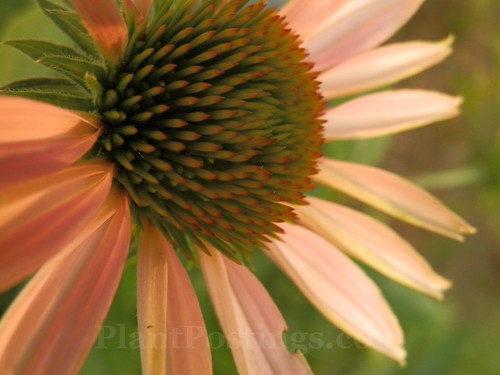
Yes, I know Purple Coneflower (Echinacea purpurea) is a common North American perennial found in many gardens. Perhaps that's why I haven't featured it as "plant of the month" until now. Maybe I take it for granted.
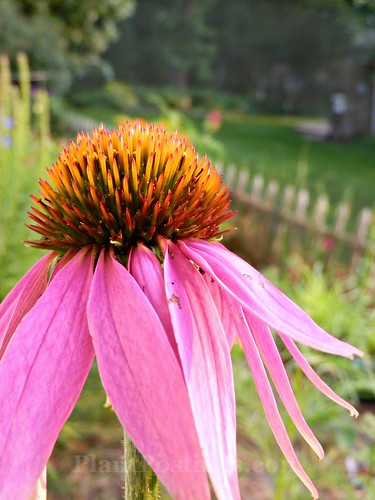
Though most of us are familiar with this beautiful, tough, flowering plant, many probably aren't aware how well it will grow in dappled or partial shade conditions. I've had it growing in the latter for many years--in my west-facing potager, where it gets bright sun for half the day. The initial plants have reliably regenerated every year for nearly two decades.

I introduced Purple Coneflower to the Oak-shaded back garden only a couple of years ago. It's taken a bit longer to get established there, but it's beginning to fill out and add its own special magic to its new location. With the south-facing back garden in dappled shade, the plants receive little glints of light throughout the day. When the sun's rays hit it just right, the plants' glowing-orb seed heads appear to be ablaze.
In shade, the blooms last longer, too, which is another pleasant discovery. So from bud in late May through final bloom in late September and seed heads in winter, this plant has staying power in dappled shade!
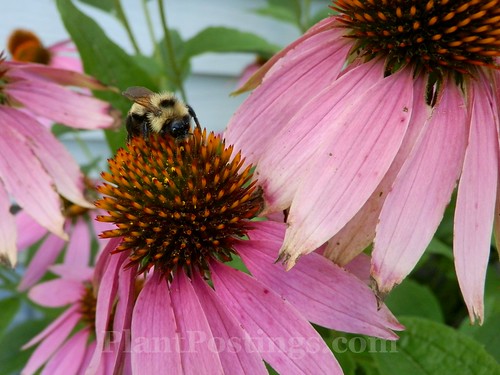
If you don't have any Echinaceas in your garden, you might want to consider them for their ease of care, drought-tolerance, beauty, and long life. They're also great cut flowers, they attract butterflies and hummingbirds, and they provide special value to native bees. In autumn and winter, the seeds offer nourishment to hungry birds.
A few more specifics about Purple Coneflower from the Lady Bird Johnson Wildflower Center:
- Native to most of Eastern and Central North America;
- Tolerates a wide range of soil types and moisture conditions;
- Height: 2-5 ft.; Width: 1-3 ft.; and
- Flowers are pink to purple, (I've found the hues are softer when grown in shade).
This common beauty is hardy in zones 3 to 10. The name Echinacea comes from the Greek "echino," meaning hedgehog--referring to the spiky cone disk at the center.
I find the stages of the flower development beautiful to watch as they transition through the growing season.

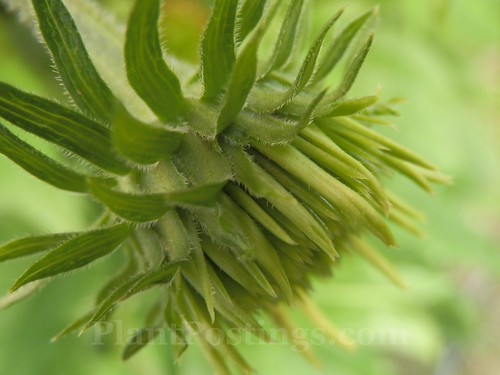
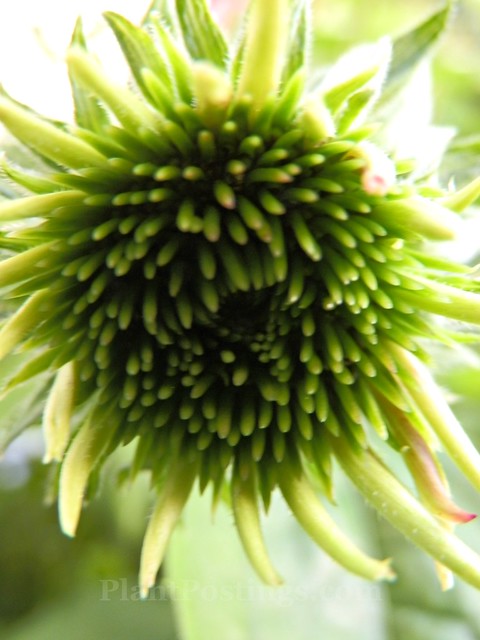


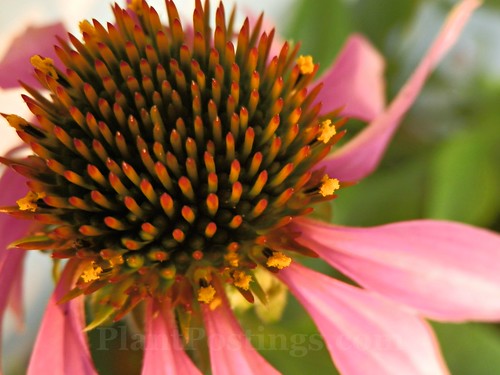


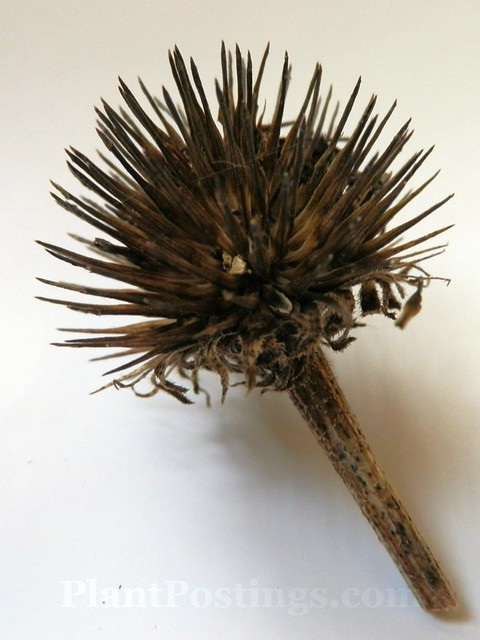
Definitely a great plant for sun, partial shade, or even dappled shade.

I'm linking this post to Gail's Wildflower Wednesday celebration. Head on over to learn about other wildflowers blooming around the world.
Worthy of a Wildflower Wednesday celebration! This is one of the ones I can count on to survive my garden...Happy WW to you.
ReplyDeleteYes, I don't know why it took me so long to feature it--too common, I guess. But, oh, so special! Thanks for hosting the meme, Gail!
DeleteThanks for the reminder of what a gorgeous plant it is. I've thought about adding it but did not realize it could take some shade which is what I mostly have, so that info is great to know.
ReplyDeleteYou're welcome. I'm sun-challenged, too. At first, I tried to put it in the sunniest spots in the garden, which worked. Then I decided to try it in the back, and I've been pleasantly surprised that it's slowly finding its place there. I don't think I'd try it in the woods, but in the "Oak opening" area it seems to be doing well.
DeleteYes,this plant is a must have in any garden. They are tough and beautiful at the same time.
ReplyDeleteLisa: I agree. I can't imagine having a garden now without Echinacea purpurea--for so many reasons.
DeleteFantastic photography of the life cycle of an echinacea bloom. I have them in abundance here, too, but they are always welcome. Some of the newer varieties lacked the staying power of the pink, but an orange one, 'Sombrero' has been a great performer for the last three or four years, too. They are all lovely plants. :-)
ReplyDeleteThank you, Karen. I know you have a great collection of Coneflowers from following your blog! I haven't tried the cultivars, but some of them are awesome, too! When they start blooming, the butterflies in the garden multiply! :)
DeleteWonderful photos, Beth--as usual. :) I'd vote for the coneflower as the plant of many months. Mine are revving up for their fall show, hopefully in time for the monarchs.
ReplyDeleteThank you, Tina! Plant of many months--I like that! You're fortunate to have them blooming through the fall. I have a few that are still blooming, but the ones on the sunny west side are winding down. Say "hi" to the Monarchs: I released quite a few this year. Some of the ones you see will probably be from Wisconsin. :)
DeleteBeautiful flower and photos, even though we are late on in the season there are still some lovely flowers to have in your garden.
ReplyDeleteAmanda xx
Thanks, Amanda. Yes, things are winding down here, but we still have a few things blooming--some are native perennials, like the Echinaceas. Others are annuals and non-native perennials. It's been very hot until today, so we're getting more blooms out of the plants this year. I like that part of the heat. ;-)
DeleteOne of my favorite plants! I let it just do it's thing so I never know where it's going to come up.....it's a great neighbor to all other perennials. Thanks for sharing!
ReplyDeleteOne of my favorites, too, Sally. I've noticed more volunteers lately, too. The one I planted in the back was one that came up in a weird place so I moved it. ;-)
DeleteBeautiful and so popular in gardens. They grow very well in Central Texas except it's one of the plants that stubbornly refuses to thrive in my garden. I like this plant so much I plan to try again now that we've created more growing areas with better soil.
ReplyDeleteI find it fascinating that it thrives in so many conditions. Sometimes I think it's just a matter of finding the right spot for it. And sometimes--like my experience in the dappled shade--it just needs a little time.
DeleteOh my goodness - I LOVE echinacea, I don't care how common they are...in fact, the more the better! My favourite is actually a white variety I have - they are beauties.
ReplyDeleteI grew Cheyenne Spirit from seed this spring and am really looking forward to their flowers next year. Just got them into the ground a few weeks ago - you know, before the September heat wave and dry spell...not exactly the best timing!
I know--great plant for just about any North American garden. 'Cheyenne Spirit' sounds like an interesting cultivar. I have a few patches of the straight species, and it's tried to re-seed itself in several spots. That's where I got the start to the plant in the dappled shade garden. I also tried to plant E. pallida in the dappled shade, but I think it needs more sun. Love that one, too! Good luck with your new plants!
DeleteWe have it growing in a bed with western exposure--full on sun for the second half of the day. Ours came from a wildflower seed mix, and we notice quite a bit of variation in the blooms. For some, the petals are very drooping, and with others they are pretty much horizontal. Also, the color intensity varies quite a bit.
ReplyDeleteI've had similar observations with the variation in color and form. Two of my patches are in western exposure like yours. They seem to love that location. But I'm amazed at how well the patch in the dappled shade is doing. I love E. pallida, too, which has the drooping petals as a common characteristic.
DeleteI love coneflowers! And I enjoyed seeing your photos.
ReplyDeleteHappy Wildflower Wednesday!
Me, too. Thank you, Lea! Still a few wildflowers blooming around here, although plants are drying up early with our drought. :(
DeleteThis is one of my favorites! You make a good point about them lasting longer in shadier conditions. That would be true especially in my southern region, where they finish blooming by mid summer. I also love watching the goldfinches feast on the seeds later in the summer.
ReplyDeleteYeah, mine in the bright western sun are drying now. But the ones in the shade still look somewhat fresh. I did deadhead a bit partway through the season to encourage additional blooms, but I like to let a lot of them dry to provide seeds for the birds. :)
DeleteI have one in deep shade and it blooms less than those in full-sun. Originally it was in dappled shade but the tree above it has grown so large the bed is in shade most of the time. As long as it is happy, I am happy.
ReplyDeleteI enjoyed the pictures showing the different stages of growth.
Thanks,
Jeannie @ GetMeToTheCountry
I like what you say: "As long as it's happy, I'm happy." That's a wise approach. I wasn't sure the one in dappled shade was going to take, but it really performed well this year after struggling the first couple of years. Thanks, Jeannie!
DeleteBeautiful! I want to grow it some day
ReplyDeleteHi Endah: Thank you! It is a beautiful and sturdy plant.
DeleteI love the Cone Part almost more than the flower.
ReplyDeleteIt brings interest into a fall bouquet of bitter sweet, drying leaves and more.
Yes, I know what you mean. I haven't used it enough in dried arrangements--thanks for the reminder. :)
DeleteI love all stages of this plant and even my bunnies love the leaves.....it is a common yet beautiful plant I also grow in all conditions....they tolerate wetter soil and shade which makes them tops for me Beth. Fabulous pictures!
ReplyDeleteThanks, Donna! The bunnies loving the leaves and stems was part of the problem for me of getting it established. LOL. But this year, it seems they were distracted by other plants. Wet, dry, sun, shade--it seems to find a way to thrive in many conditions. :)
DeleteI pulled out all my Echinaceas because of aster yellows. They are wonderful plants, though. I'm thinking of giving them a try, maybe E. paradoxa. Do you have problems with flopping when you grow them in shade?
ReplyDeleteAh, yes, that can be an issue with this plant. I probably should have mentioned it in the post. I really like E. pallida, too, although it didn't like my garden as much as E. purpurea does. I'm not as familiar with E. paradoxa. No problems with flopping in the shade. The stems are sturdy. The only differences were that it took a little longer to establish, and the color is more subdued. Oh, and the blooms last longer in the shade here.
DeleteBeth, the same thoughts came into my head while reading your post and in putting together my juniper post—about how blogging encourages us to look and learn!! Your photos of the developing flower head are so interesting. I will definitely look closely at young coneflowers next year ... and think of you too :-)
ReplyDeleteThat is so true, Hollis! I feel like my world has expanded and improved in such amazing ways since I started blogging. The act of blogging, and the exercise of thinking about posting, as well as visiting other blogs--all these things contribute to learning and growing. I loved your Juniper post!
DeleteYour photos of the developing flower are amazing. Thank you for sharing.
ReplyDeleteThanks, Carla. Such a wonderful plant!
DeleteI love echinaceas too,specially en masse. Have you tried any of the lovely new hybrids? They neverlast in my garden.
ReplyDeleteHi Chloris: I like big swathes of them, too. I only have three patches of them here, but two of the clumps are pretty substantial. No, I've never tried the hybrids.
DeleteEchinaceas are wonderful and deserving of being featured. I've found although they are drought-resistant, to look their best they appreciate a good drink of water.
ReplyDeleteYes, they're reliable and fabulous. Mine tend to get watered regularly because they're in areas of the garden with veggies and annuals and other perennials. But I've seen them in the wild during droughts and they seem to do pretty well...unless the drought lasts too long. I tend to deadhead them at first, and then let them go to seed for the songbirds.
DeleteSuch a hardworking plant! I love how much the wildlife love them, though our groundhog likes them a little too much. That's interesting to know that they do well in some shade too.
ReplyDeleteYes, hardworking is a good way to put it. Oh darn--too bad the groundhog found yours! Yes, I've been surprised about the plant in the dappled shade. Hopefully, it will continue to thrive...and maybe spread some seed in that area.
DeleteYou know this is my favorite plant, Beth--definitely worthy of "plant of the month" status! Besides the fact that I just love the flowers when blooming, I think what really makes them endearing to me is that they are so tough and need little attention. And every year they gift me with a few new plants!
ReplyDeleteYes, I know you are a big fan, too, Rose. :) We both look forward to the butterflies that visit when the Echinaceas start to bloom. And they are tough, beautiful plants!
Delete